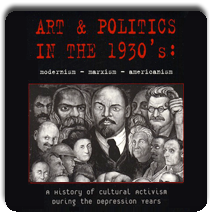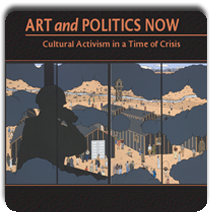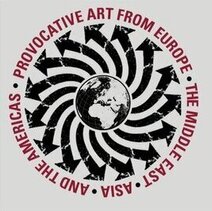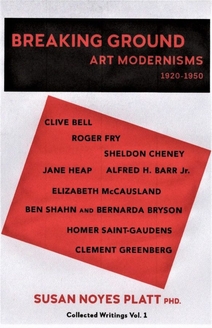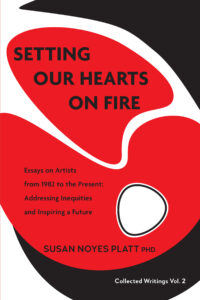Beyond the Mountain at the Asian Art Museum
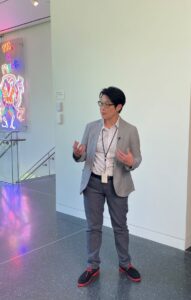
FOONG Ping, Foster Foundation Curator of Chinese Art here introduces her new show “Beyond the Mountain: Contemporary Chinese artists on the Classical Forms” to our press corps in Seattle. I have to warn you that I am a Ping groupie, I think she is really brilliant based on her lecture to members and her interpretations of the shows and installations she curates with Xiaojin Wu, the Curator of Japanese and Korean Art, and most recently with Natalia Di Pietrantonio, Seattle Art Museum’s first curator of South Asian art.
This particular exhibition has another exciting resonance, it was developed in collaboration with the students of “Exhibiting Chinese Art,” Spring 2020 Zoom seminar, University of Washington.
“Beyond the Mountain” gives us six contemporary Chinese artists who negotiate, alter and reinvent some of the deeply classical traditions of China. Ink painting is a central theme in two of the artists.
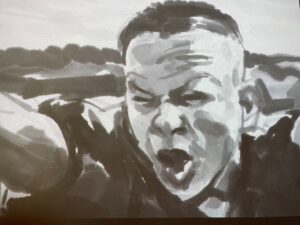
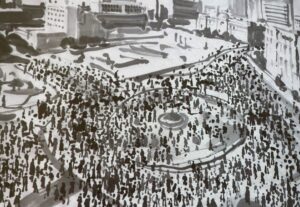
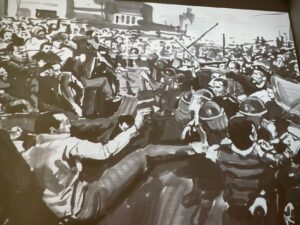
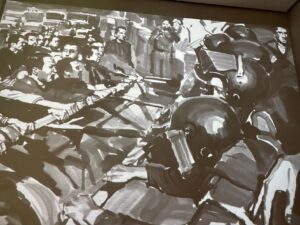
Ink/Protest
We begin with Chen-Shaoxiong (1962 – 2016) His video assembles hundreds of ink paintings of protests around the world, based on images he downloaded from the internet.
Here we have the most deeply revered technique of Chinese ink painting used to present the resistance to authority from Occupy Wall Street to Hong Kong. He depicts the protestors resisting police everywhere. the artist simply calls his works Ink Media, a clever ploy that ignores the imagery for authorities who might object?
The artist clearly has a dazzling facility with ink painting, but he is also deeply political. With Liang Juhui 梁矩辉 ( 1959-2006), Lin Yi Lin 林一林 (1964 ), the group Big Tail Elephant protested the rapidly urbanizing Southern city of Guangzhou with performance, photography, installations, and video placed in parks and other public places.
Landscape/Cityscape
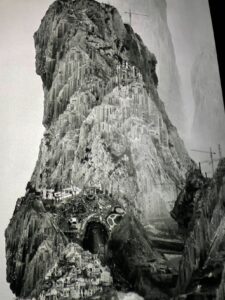
The Departure
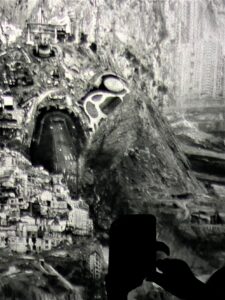
Yang-Yongliang evokes ink painting in state of the art digital works. Song dynasty monumental landscape paintings celebrated nature and the idea of slowly moving through it as we looked at the painting. Yang-Yongliang ( born in 1980) studied traditional Chinese painting. His videos, like Song landscapes, demand long slow viewing. As we look we begin to see that these are not natural mountains, but actually dense skyscrapers that build up into a mountain. A slow movement of water, as well as tiny people, and cars on highways, slows us down to wait for an event which never comes. We see the water flow, but it never arrives in the sea. we see the dog run, the man fish, the car arrive, but nothing happens, it is an event without an event.
As the press release states eloquently “The aesthetic expressions of old master paintings require close, patient attention to their rich detail, as they mimic traveling at a slow pace to places where the body cannot follow. The purpose of Song painting was twofold: rejuvenation—to relieve stress by countering the chaos of daily life with uplifting, virtual experiences of nature—and contemplation of human (in)significance in the face of nature’s inexorable forces. ”
But these paintings tell us a different story as we are mesmerized by their slow slow movement. We stop, we look, but now we see that while we are insignificantly small, we are destroying the earth. Here
I include an arm of a viewer to give a sense of the scale
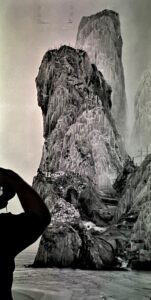
the Return
artifact/culture
The gallery between these two experimental artists features two familiar works, one by AiWeiWei. Ai Wei Wei’s 2020 gesture in putting contemporary garish enamel colors on what appear to be old clay pots, is one of many of his outrageous acts over the years. It is less inflammatory than many though. For those of us who have followed his career for many years, this early work is pretty benign, but as you think about the reverence that classical pottery holds in China (perhaps not anymore, and certainly not during the Communist era when classical art was often destroyed) it still carries a lot of content. But if you are not Chinese, or versed in Chinese art, it might not come across as more than pots with bright paint messily applied.
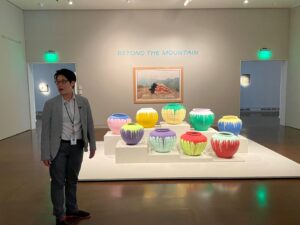
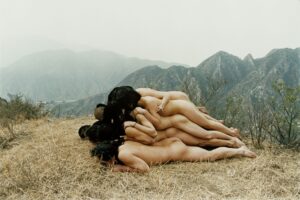
The other work by Zhang Huan. “To Add One Meter to an Anonymous
Mountain,” 1995 is a well known early work by a well known artist.
He piled up bodies on a mountain and added one meter to a vast landscape, again suggesting the insignificance of humans in the scale of nature and the Chinese proverb “Beyond the mountain, there are higher mountains yet,”
landscape/escape
The final room of the exhibition by Lam Tung Pang is by far the most
difficult to understand. Created during the pandemic, it is about being isolated and enclosed and finding a means of escape through fantasy, imagination, and technology. An enclosed space that we are not allowed to enter has a projector that sends various images onto the walls of the enclosure as well as around the room. we become part of the show sometimes. Images include someone gazing at a huge ball of sun or earth, a girl riding a blind-folded donkey, a goose plummeting to the ground ( you can barely see that here) and many other elusive details.
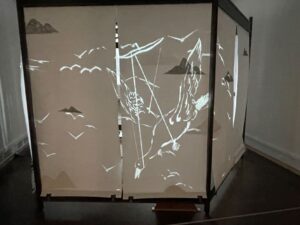
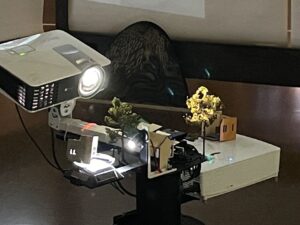
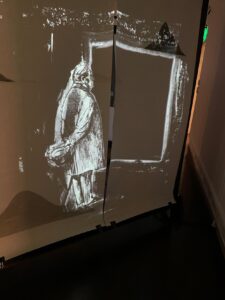
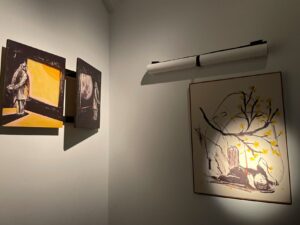
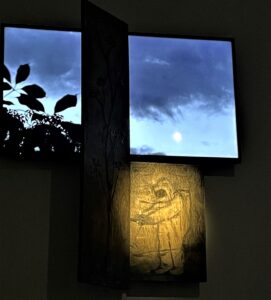
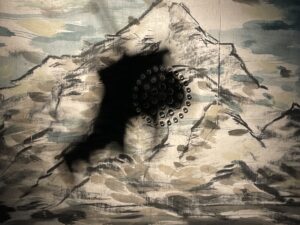
Two other works in the room suggest space flight, Someone a Day 521
and crashing into a mountain, in Echo ( a tiny astronaut is suspended from the ceiling and his shadow appears on the mountain)
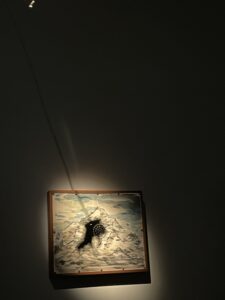
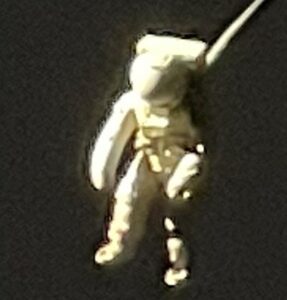
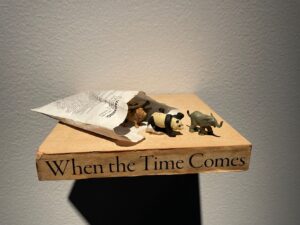
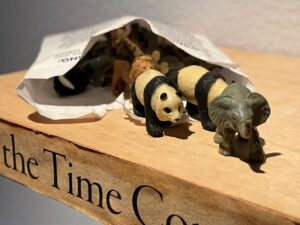
and a 2013 work called “When the Time Comes” features a type of bizarre Noah’s ark image of animals marching out of an envelope
All together the installation suggests anxiety, instability, and a search for something solid. It feels like the isolation of the pandemic left the artist floating in mid air like the astronaut that approaches Echo
The exhibition as a whole provokes us with its dialog with history, but most of all it speaks to the present and our current planetary crisis. Disruption of history is where we are now, and destruction of the planet is ongoing. Our small presence within this extraordinary home of ours is creating an outsized impact.
This entry was posted on August 30, 2022 and is filed under Uncategorized.


